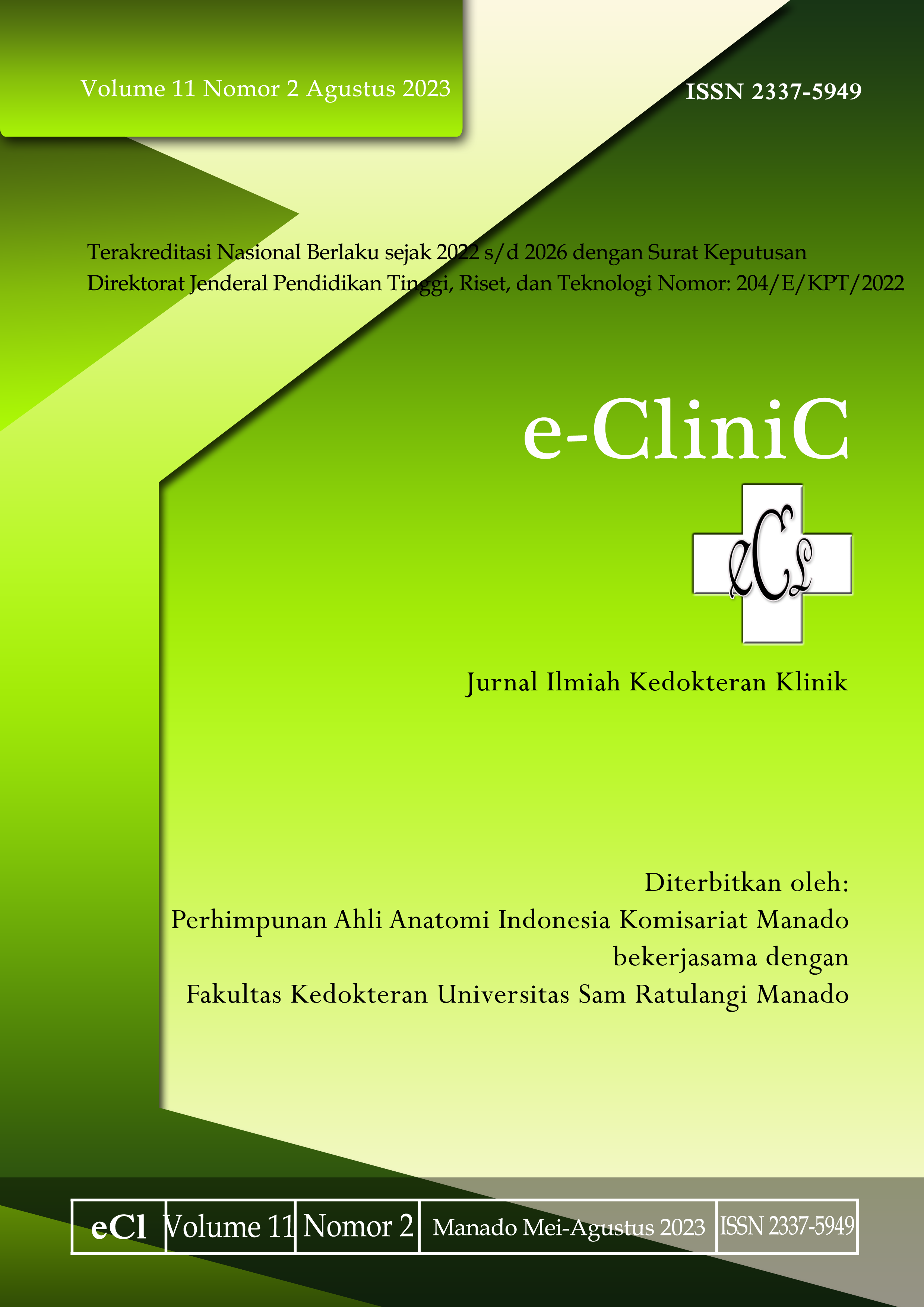Burn Hypertrophic Scar Profile Based on POSAS Score at Prof. Dr. R. D. Kandou Hospital Manado
DOI:
https://doi.org/10.35790/ecl.v11i2.46370Abstract
Burn injury is skin damage due to extreme temperature resulting in hypertrophic scar if impaired of wound healing occurs that can impact on the quality of life. Evaluation of hypertrophic scar objectively and subjectively including scar quality and quality of life patient could performed with POSAS score. This study aimed to evaluate burn hypertrophic scar profile based on POSAS core at Prof. Dr. R. D. Kandou Hospital Manado. This was a retrospective study using medical records of burn patients from 2018 to 2020 at Prof. Dr. R. D. Kandou Hospital. The results obtained 64 samples. Most of the patients were male (75.0%). The most dominant age of patients was over the age of 21 years (79.7%). The most frequent cause of burns was exposure to hot water (71.9%) followed by fire (21.9%). The undergraduate education level was the most affected by burns (79.7%). The type of work most affected was the professional group (62.5%) followed by housewives (18.8%). Most of the wounds were superficial-middermal degree (71%) followed by superficial degree (15,6%) and deep dermal full thickness (12,5%). Assessment of hypertrophic scars using the POSAS score showed almost the same results between observers and patients. In conclusion, hypertrophic scar evaluation with POSAS score is very useful because it can evaluate the scar quality and the quality of life. POSAS score evaluation is depended on wound treatment, duration of wound healing, grading and wound burn area, and length of stay.
Keywords: hypertrophic scar; POSAS score; quality of life
References
Brunicardi CF, Hunter JG, Billiar TR, Andersen DK, Matthews JB, Dunn DL, et al. Schwartz’s Principles of Surgery (10th ed). New-York: McGraw-Hill Education; 2014. p. 228-9.
Kaddoura I, Abu-Sittah G, Ibrahim A, Karamanoukian R, Papazian N. Burn injury: review of pathophysiology and therapeutic modalities in major burns. Ann Burns Fire Disasters. 2017;30(2):95-102.
Badan Penelitian dan Pengembangan Kesehatan. Pokok-pokok Hasil Riskesdas Indonesia 2013. Jakarta: Kementerian Kesehatan Republik Indonesia; 2013.
Brodie L et al. Emergency Management of Severe Burns EMSB (17th ed). ANZBA Association. 2013; p 39-42.
van der Wal MBA, Tuinebreijer WE, Bloemen MCT, Verhaegen PDHM, Middelkoop E, van Zuijlen PPM. Rasch analysis of the patient and observer scar assessment scale (POSAS) in burn scars. Qual Life Res. 2012;21(1):13-23. Doi: 10.1007/s11136-011-9924-5.
Lam NN, Hung NT, Duc NM. Influence of gender difference on outcomes of adult burn patients in developing country. Ann Burns Fire Disasters. 2019;32(3):175-8.
Ramli RN, Prawoto A, Riasa NP, Saputro ID, Mas’ud AF. Epidemiology and knowledge of first aid treatment related to burn injury in the rural region of Kulon Progo, Indonesia. Open Access Maced J Med Sci [Internet]. 2021;9(E):101-8. [cited 2023 Apr. 26]. Available from: https://oamjms. eu/index.php/mjms/article/view/5649
Kobayashi K, Ikeda H, Higuchi R, Nozaki M, Yamamoto Y, Urabe M, et al. Epidemiological and outcome characteristics of major burns in Tokyo. Burns. 2005;31(Suppl 1):S3-11. Doi: 10.1016/j.burns. 2004.10.007.
Wardhana A, Basuki A, Prameswara ADH, Rizkita DN, Andarie AA, Canintika AF. The epidemiology of burn in Indonesia’s national referral burn center from 2013 to 2015. Burn Open. 2017;1(2): 67-73.
Schulz JT, Shapiro GD, Acton A, Fidler P, Marino ME, Jette A, et al. The relationship of level of education to social reintegration after burn injury: A LIBRE Study. J Burn Care Res. 2019;40(5):692-702. Doi: 10.1093/jbcr/irz074.
Downloads
Published
How to Cite
Issue
Section
License
Copyright (c) 2023 Mendy Hatibie, Maximillian C. Oley, Eko S. Sinaga

This work is licensed under a Creative Commons Attribution-NonCommercial 4.0 International License.
COPYRIGHT
Authors who publish with this journal agree to the following terms:
Authors hold their copyright and grant this journal the privilege of first publication, with the work simultaneously licensed under a Creative Commons Attribution License that permits others to impart the work with an acknowledgment of the work's origin and initial publication by this journal.
Authors can enter into separate or additional contractual arrangements for the non-exclusive distribution of the journal's published version of the work (for example, post it to an institutional repository or publish it in a book), with an acknowledgment of its underlying publication in this journal.
Authors are permitted and encouraged to post their work online (for example, in institutional repositories or on their website) as it can lead to productive exchanges, as well as earlier and greater citation of the published work (See The Effect of Open Access).







